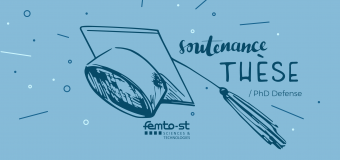You are here
- Home
- Charles LORENZO : "Methodology and tools for the multicriteria optimization of a hybrid electric hydrogen train architecture""

Charles LORENZO : "Methodology and tools for the multicriteria optimization of a hybrid electric hydrogen train architecture""
Wednesday 17th November 2021 - 2.00 P.MPhD works of Charles LORENZO :"Methodology and tools for the multicriteria optimization of a hybrid electric hydrogen train architecture"
Abstract : Decarbonization of the transport sector is currently a major concern for the various actors involved. Driven by the rise of the hydrogen industry, hybrid hydrogen trains are promoted as a solution for the future of sustainable mobility. The recent integration of hydrogen fuel cells
in the railway industry offers promising prospects to reduce carbon emissions while ensuring high autonomy. The work achieved in this thesis is in line with this context and aims at developing a complete methodology for sizing the energetic architecture of the hybrid-electric hydrogen
trains. Sizing a railway hybrid vehicle is challenging because numerous and conflicting criteria must be managed in parallel, such as sources lifespan, energy efficiency, and fuel consumption while taking into account the integration constraints and the operator requirements. In
addition, the total cost of the solution must be considered over the lifetime of the vehicle. A multi-criteria optimization is therefore necessary, both on the architecture of the traction chain and on the energy management. A tool has been designed to determine the characteristics of the fuel cell, the battery, and the energy management strategy that will minimize the global cost of the train. To this end, we first developed a model of the train architecture to estimate the energy characteristics of the fuel cell and the battery on duty cycles. Based on the assessment of the degradation mechanisms of these sources, ageing models have been established and help estimate their lifespan on the studied cycles. Four energy management strategies have been designed to minimize the cost related to source operation over the duty cycles. The tool thus developed performs multi-criteria optimization on the different sources and energy management strategies studied, enabling to identify the optimal energetic sizing. Thanks to the partnership with the train manufacturer Alstom, we were able to use this tool on a concrete railway project with real duty cycles, demonstrating its relevance and effectiveness.
Jury Composition :
M. Daniel HISSEL Professeur des universités Université Bourgogne Franche-Comté - HDR Director
M. David BOUQUAIN Professeur des universités Université Bourgogne Franche-Comté - HDR Co-Director
M. SAMUEL HIBON Ingénieur Alstom - HDR Co-Supervisor
M. Alain BOUSCAYROL Professeur des universités Université de Lille - Reporter
M. Jean-Michel VINASSA Professeur des universités Bordeaux INP - Reporter
Mme Melika HINAJE Professeur des universités Université de Lorraine - Reviewer
Mme Véronique ANDRIES Docteure Alstom - Reviewer
M. Javier SOLANO Professeur associé Universidad Industrial de Santander - Reviewer
Localization : UFR STGI - 2, Rue Chantereine 90000 BELFORT - Room : Amphithéâtre 302









